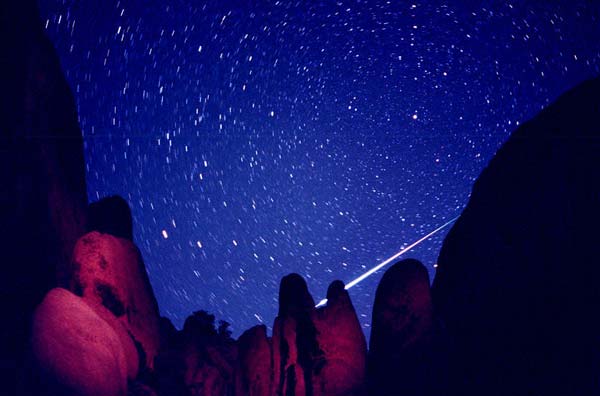
|
Credit & Copyright: Wally Pacholka
Explanation:
Polaris is quite an unusual star. First,
Polaris is the nearest bright star to the
north spin axis of the Earth.
Therefore, as the Earth turns, stars appear to
rotate around Polaris, making it the
North Star.
Since no bright star is near the south spin axis of the Earth,
there is currently no South Star.
Thousands of years ago, Earth's spin axis pointed in a
slightly different direction, and
Vega was the North Star.
Although Polaris is not the brightest star on the sky, it is easily located
because it is nearly aligned with two stars in the cup of the Big Dipper, and is the last star in the handle of the
Little Dipper.
In the above picture,
Polaris is the brightest star on the right,
above the fleeting streak of a
Perseid meteor.
The surface of
Polaris slowly pulsates, causing the star to
change its brightness by a few percent over the course of a few days.
This rare
Cepheid variability
of Polaris is, oddly enough,
itself changing.
|
January February March April May June July August September October November December |
| ||||||||||||||||||||||||||||||||||||||||||||||||
NASA Web Site Statements, Warnings, and Disclaimers
NASA Official: Jay Norris. Specific rights apply.
A service of: LHEA at NASA / GSFC
& Michigan Tech. U.
Based on Astronomy Picture
Of the Day
Publications with keywords: cepheid - Earth's rotation - north star - polaris - star
Publications with words: cepheid - Earth's rotation - north star - polaris - star
See also:
- APOD: 2025 June 11 Á 25 Brightest Stars in the Night Sky
- APOD: 2025 January 14 Á North Star: Polaris and Surrounding Dust
- APOD: 2024 June 16 Á Animation: Black Hole Destroys Star
- APOD: 2023 April 11 Á North Star: Polaris and Surrounding Dust
- The 25 Brightest Stars in the Night Sky
- 2MASS J17554042 6551277
- North Star: Polaris and Surrounding Dust
